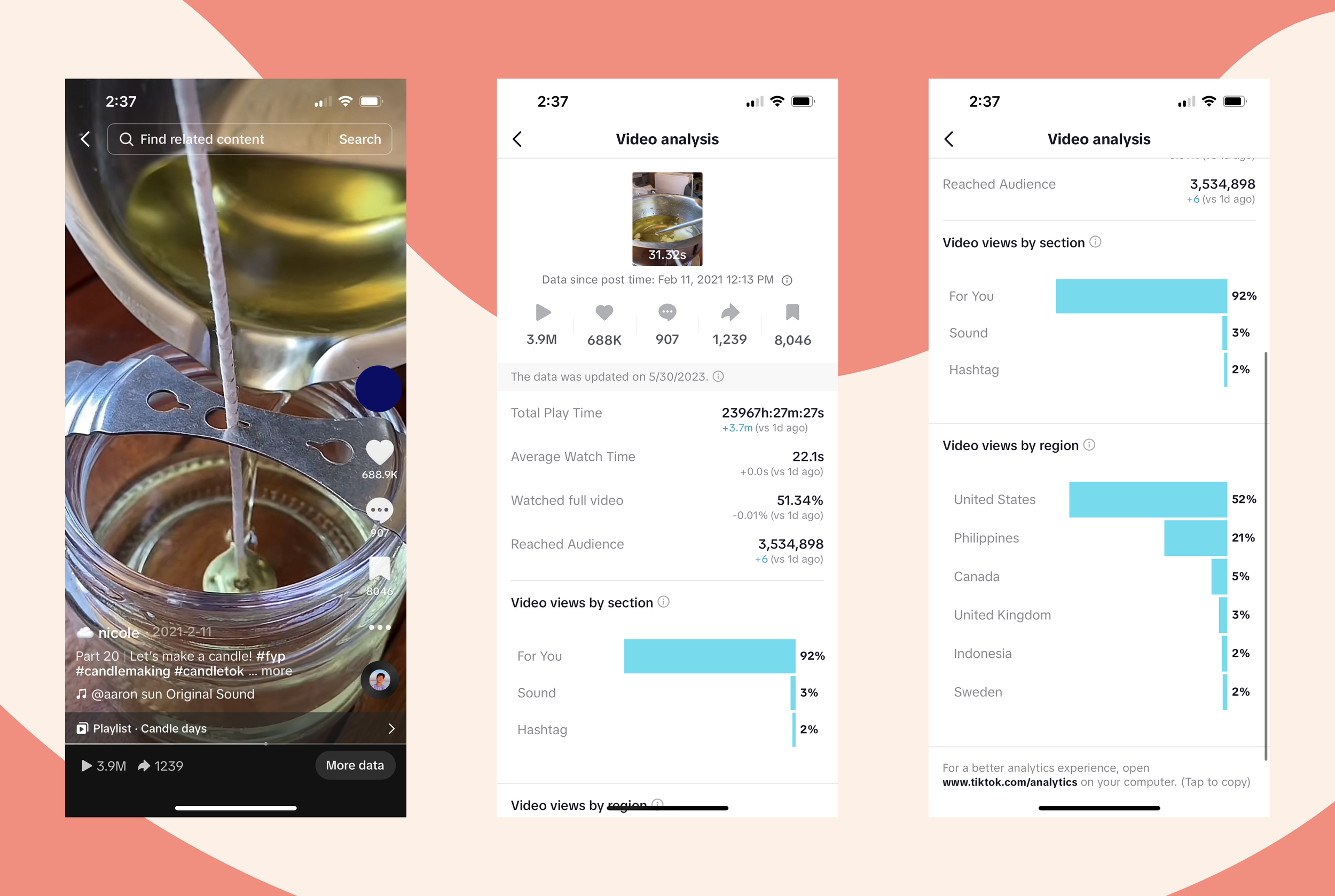5 useful tips to master your TikTok marketing strategy
Whether you're a seasoned marketer or a digital marketing newbie, launching a successful TikTok campaign can be a game-changer. With over 1 billion active users, it is a powerful platform for businesses of all sizes to reach new customers and grow their brand. However, millions of other businesses are doing the exact same thing and standing out from the crowd requires a strategic approach and a creative mindset.
Research has shown that an Android app user spent an average of 23.5 hours per month on TikTok in 2022
In this article, we will uncover the five key things that OtterHalf takes note of before launching a TikTok campaign. By following these tips and insights, you will be able to execute an impactful TikTok campaign that resonates with your target audience and produces tangible results. Ready? Let’s go!
A TikTok video created by Nicole, OtterHalf’s Senior Consultant, for her candle business that garnered 3.9 million views in 7 days
1. Planning your marketing strategy
Defining Campaign Goals
Before diving into your TikTok campaign, set one or two main objectives you wish to achieve, whether it’s driving traffic to your website, increasing brand awareness, or promoting your product. Clearly defining your goals will help you stay focused throughout the campaign and measure its success.
Determine your Target Market
Next, you need to identify your target market. To do this, create personas based on your campaign goals you set. Here are some questions to help you formulate your personas:
What is their age range? Are they older Gen Zs, aged 18-26? Are they millennials, ranging between 27-42?
What is the estimated gender distribution of your videos? Are there more women watching your content, or men?
What kind of content do they like to watch? What niche of Tok are they in? FoodieTok? SwiftTok? OtterTok?
What are their interests, preferences, and behaviors?
If your business already has an established social media presence, it is best to utilise your TikTok analytics to gain insight into your audience’s demographics and preferences. However, if your TikTok account is relatively new, one tip is to observe the characteristics of the profiles who are commenting and engaging with your competitor’s content. From there, you can piece together a rough profile of your target market.
Determine the Campaign Type
Thereafter, you need to decide the type of campaign you want to launch. Will it be organic, paid, or both?
If your goal is to drive sales of a new product, launching an organic campaign does not guarantee the best results due to the arbitrary nature of the algorithm on TikTok. In this case, it might benefit your business more to pursue a paid campaign, as this will allow you to reach your target audience more accurately. You are able to add actionable CTAs for paid campaigns, which would redirect your audience to the product’s purchase page.
Alternatively, you can consider running both types of campaigns simultaneously to maximize your reach. An approach that we recommend would be to release weekly organic educational or lifestyle content about your new product while running targeted ads to increase the visibility of your post.
Content Pillars
Categorising your content into distinct categories, known as content pillars, can ensure a consistent viewing experience. These categories may include comedy, motivation, tutorials, The More You Knows, or other relevant niches that align with your audience. We’ve found this approach particularly helpful in creating a diverse range of content that caters to different segments of our target market, each with unique interests and preferences.
Research has revealed that 79.8% of active TikTok users, aged 16 to 64, used the platform to look for funny and entertaining videos
Call-To-Action (CTA)
Lastly, and most importantly, you should establish a compelling CTA that directs your audience towards the desired action. This CTA can take on various forms - whether it’s adding a “shop now” button directly on your TikTok ad, or urging viewers to click the link on your bio after your TikTok video ends, or encouraging your audience to comment their thoughts on your TikTok video, which can increase your video’s engagement and foster a sense of community around your business.
2. Creating a Content Calendar & Sticking With It
Once your campaign planning is ironed out, the next step is to create a content calendar. This step is essential as it saves you the hassle of thinking about new content on the fly and allows you to allocate your time more efficiently.
Start by deciding the duration of your campaign. Will it span over 2 weeks, a month, or even longer? Once you have finalised the campaign duration, you can proceed to create a content calendar. Developing a content calendar from scratch can be a daunting task, but don’t worry, you can download a free TikTok content calendar template that the OtterHalf team uses to assist you in your planning!
A well-planned content calendar serves multiple purposes: it helps you strategise your filming approach effectively, acts as your roadmap when launching any marketing campaign, keeps you organised, and ensures your campaign stays on track to achieve your goals.
3. Formulate a Filming and Editing Strategy
Maximize the efficiency of your filming process by breaking the sessions according to the type of work involved. For instance, dedicate one session to filming videos that require on-camera talking, and another session for videos that utilize specific sounds or feature product shots. When it comes to editing, consider separating text edits and music inclusions into a separate session. By organizing your content workflow in this way, you can optimize your time and work more efficiently.
4. Using the Appropriate Hashtags
Avoid common pitfalls when using hashtags on TikTok. Including hashtags like #cuteotters or #harrystylesloveontour in captions promoting a productivity app would be considered misuse, as they are completely irrelevant and have no connection to your campaign
Another pitfall is hashtag abuse, which occurs when you use multiple hashtags that mean the same thing. For instance, hashtags like #agency, #marketingagency, and #marketingagency2023 would be repetitive for a video about a marketing agency.
To use hashtags effectively, focus on a few key hashtags that directly relate to your campaign, target market, and goals. Supplement them with some relevant hashtags that offer variety. Research content related to your campaign, observe relevant and trending hashtags, and choose the ones that align with your objectives.
Tried and tested pro-tip: Steer clear of hashtags like #fyp or #xyzbca, as they do not directly impact content visibility. Contrary to popular belief, using these hashtags doesn’t guarantee that your content will be featured on the “For You” tab on TikTok, which is the ultimate aim for most TikTok content creators as it increases video exposure to a broader audience.
5. Monitor Your Performance Religiously
Monitoring your campaign’s performance is crucial, even if it may seem tedious, as it allows you to make data-driven decisions and optimise your TikTok strategy for better results. We recommend reviewing your campaigns bi-weekly to track engagement, profile visits, and content performance based on your content pillars. Analyse which content pillars are generating the most impact and adjust your strategy accordingly. Download the exact performance tracking template that the OtterHalf team uses for all their TikTok campaigns, for free!
How performance tracking can help optimise your TikTok Campaign: if you notice that videos under certain content pillars e.g Tutorials are not generating engagement or profile visits, you can decide whether to remove that content particular pillar from your campaign and allocate more posts to other pillars that would help you achieve your goals.
Need assistance in applying these 5 tips in launching your next TikTok campaign? We might be a fit.






